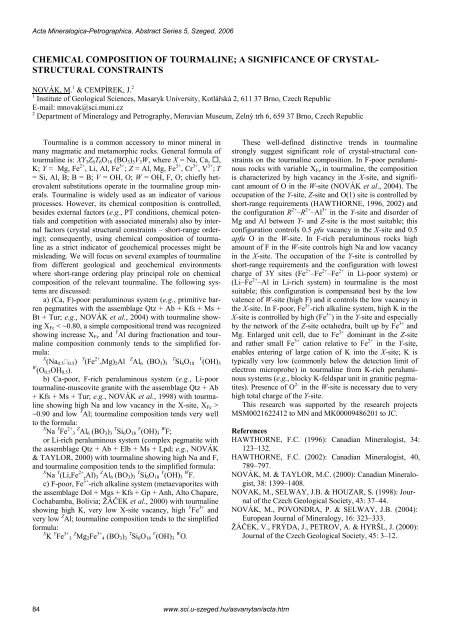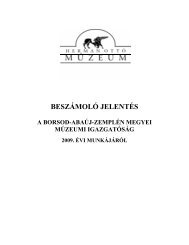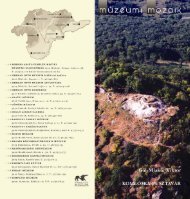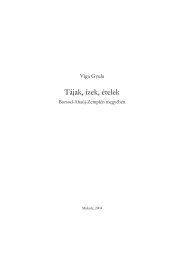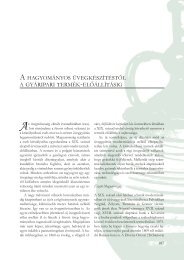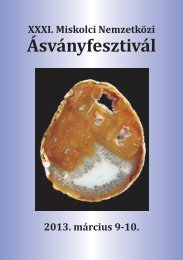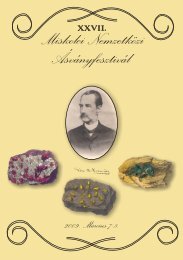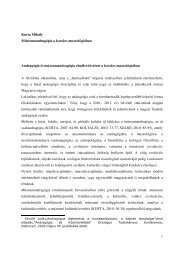MSCC3 3rd MINERAL SCIENCES IN THE CARPATHIANS ...
MSCC3 3rd MINERAL SCIENCES IN THE CARPATHIANS ...
MSCC3 3rd MINERAL SCIENCES IN THE CARPATHIANS ...
Create successful ePaper yourself
Turn your PDF publications into a flip-book with our unique Google optimized e-Paper software.
Acta Mineralogica-Petrographica, Abstract Series 5, Szeged, 2006CHEMICAL COMPOSITION OF TOURMAL<strong>IN</strong>E; A SIGNIFICANCE OF CRYSTAL-STRUCTURAL CONSTRA<strong>IN</strong>TSNOVÁK, M. 1 & CEMPÍREK, J. 21 Institute of Geological Sciences, Masaryk University, Kotlářská 2, 611 37 Brno, Czech RepublicE-mail: mnovak@sci.muni.cz2 Department of Mineralogy and Petrography, Moravian Museum, Zelný trh 6, 659 37 Brno, Czech RepublicTourmaline is a common accessory to minor mineral inmany magmatic and metamorphic rocks. General formula oftourmaline is: XY 3 Z 6 T 6 O 18 (BO 3 ) 3 V 3 W, where X = Na, Ca, ,K; Y = Mg, Fe 2+ , Li, Al, Fe 3+ ; Z = Al, Mg, Fe 3+ , Cr 3+ , V 3+ ; T= Si, Al, B; B = B; V = OH, O; W = OH, F, O; chiefly heterovalentsubstitutions operate in the tourmaline group minerals.Tourmaline is widely used as an indicator of variousprocesses. However, its chemical composition is controlled,besides external factors (e.g., PT conditions, chemical potentialsand competition with associated minerals) also by internalfactors (crystal structural constraints – short-range ordering);consequently, using chemical composition of tourmalineas a strict indicator of geochemical processes might bemisleading. We will focus on several examples of tourmalinefrom different geological and geochemical environmentswhere short-range ordering play principal role on chemicalcomposition of the relevant tourmaline. The following systemsare discussed:a) (Ca, F)-poor peraluminous system (e.g., primitive barrenpegmatites with the assemblage Qtz + Ab + Kfs + Ms +Bt + Tur; e.g., NOVÁK et al., 2004) with tourmaline showingX Fe < ~0.80, a simple compositional trend was recognizedshowing increase X Fe and Y Al during fractionation and tourmalinecomposition commonly tends to the simplified formula:X (Na 0.5 0.5 ) Y (Fe 2+ ,Mg) 2 Al Z Al 6 (BO 3 ) T 3 Si 6 O V 18 (OH) 3W (O 0.5 OH 0.5 ).b) Ca-poor, F-rich peraluminous system (e.g., Li-poortourmaline-muscovite granite with the assemblage Qtz + Ab+ Kfs + Ms + Tur; e.g., NOVÁK et al., 1998) with tourmalineshowing high Na and low vacancy in the X-site, X Fe >~0.90 and low Y Al; tourmaline composition tends very wellto the formula:X Na Y Fe 2+ 3 Z Al 6 (BO 3 ) T 3 Si 6 O V 18 (OH) W 3 F;or Li-rich peraluminous system (complex pegmatite withthe assemblage Qtz + Ab + Elb + Ms + Lpd; e.g., NOVÁK& TAYLOR, 2000) with tourmaline showing high Na and F,and tourmaline composition tends to the simplified formula:X Na Y (Li,Fe 2+ ,Al) Z 3 Al 6 (BO 3 ) T 3 Si 6 O V 18 (OH) W 3 F.c) F-poor, Fe 3+ -rich alkaline system (metaevaporites withthe assemblage Dol + Mgs + Kfs + Gp + Anh, Alto Chapare,Cochabamba, Bolivia; ŽÁČEK et al., 2000) with tourmalineshowing high K, very low X-site vacancy, high Y Fe 3+ andvery low Z Al; tourmaline composition tends to the simplifiedformula:X K Y Fe 3+ 3 Z Mg 2 Fe 3+ 4 (BO 3 ) T 3 Si 6 O V 18 (OH) W 3 O.These well-defined distinctive trends in tourmalinestrongly suggest significant role of crystal-structural constraintson the tourmaline composition. In F-poor peraluminousrocks with variable X Fe in tourmaline, the compositionis characterized by high vacancy in the X-site, and significantamount of O in the W-site (NOVÁK et al., 2004). Theoccupation of the Y-site, Z-site and O(1) site is controlled byshort-range requirements (HAWTHORNE, 1996, 2002) andthe configuration R 2+ –R 2+ –Al 3+ in the Y-site and disorder ofMg and Al between Y- and Z-site is the most suitable; thisconfiguration controls 0.5 pfu vacancy in the X-site and 0.5apfu O in the W-site. In F-rich peraluminous rocks highamount of F in the W-site controls high Na and low vacancyin the X-site. The occupation of the Y-site is controlled byshort-range requirements and the configuration with lowestcharge of 3Y sites (Fe 2+ –Fe 2+ –Fe 2+ in Li-poor system) or(Li–Fe 2+ –Al in Li-rich system) in tourmaline is the mostsuitable; this configuration is compensated best by the lowvalence of W-site (high F) and it controls the low vacancy inthe X-site. In F-poor, Fe 3+ -rich alkaline system, high K in theX-site is controlled by high (Fe 3+ ) in the Y-site and especiallyby the network of the Z-site octahedra, built up by Fe 3+ andMg. Enlarged unit cell, due to Fe 3+ dominant in the Z-siteand rather small Fe 3+ cation relative to Fe 2+ in the Y-site,enables entering of large cation of K into the X-site; K istypically very low (commonly below the detection limit ofelectron microprobe) in tourmaline from K-rich peraluminoussystems (e.g., blocky K-feldspar unit in granitic pegmatites).Presence of O 2- in the W-site is necessary due to veryhigh total charge of the Y-site.This research was supported by the research projectsMSM0021622412 to MN and MK00009486201 to JC.ReferencesHAWTHORNE, F.C. (1996): Canadian Mineralogist, 34:123–132.HAWTHORNE, F.C. (2002): Canadian Mineralogist, 40,789–797.NOVÁK, M. & TAYLOR, M.C. (2000): Canadian Mineralogist,38: 1399–1408.NOVAK, M., SELWAY, J.B. & HOUZAR, S. (1998): Journalof the Czech Geological Society, 43: 37–44.NOVÁK, M., POVONDRA, P. & SELWAY, J.B. (2004):European Journal of Mineralogy, 16: 323–333.ŽÁČEK, V., FRÝDA, J., PETROV, A. & HYRŠL, J. (2000):Journal of the Czech Geological Society, 45: 3–12.84www.sci.u-szeged.hu/asvanytan/acta.htm


